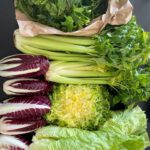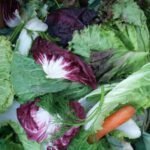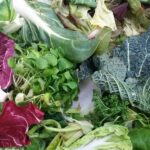The secret of a need-based diet
Thousands of rabbits in Germany and worldwide are overfed, and just as many suffer from deficiencies. These two extremes are often linked and not clearly separable, because rabbits that are fed inappropriate foods frequently have an excess of certain substances while at the same time experiencing severe shortages of others.
Contents
- Commercial Feed – Deficiency in Abundance
- Additives of Synthetic Vitamins and Carotenoids
- What is the difference between synthetic and natural vitamins?
- Artificial vitamins are produced in laboratories, while natural vitamins are formed in plants.
- Advantages of natural vitamins compared to synthetic ones
- Example: Vitamin A
- Why is an overdose harmful?
- Can’t we perfectly imitate nature and produce a good feed?
- Budget feeding – missing the animals’ actual needs
- β-carotene–rich plants (µg per 100 g)
- β-carotene–rich dried components (µg per 100 g)
- Vitamin-E–rich plants (µg per 100 g)
- Vitamin-E–rich seeds (µg per 100 g)
- Water…
Commercial Feed – Deficiency in Abundance
Feeding rabbits with commercially available mixed feeds or pelleted products is very common in Germany and worldwide. The packaging often claims to provide everything the animal needs. In reality, many essential components (such as secondary plant compounds) are missing, while other substances are included that aren’t necessary at all — and some required vitamins are massively overdosed.
“No industrial feed is so optimal that it won’t eventually cause illness due to its one-sided composition […] Industrial feed makes animals sick in the long run.”
– Dr. med. vet. Vera Biber –
Additives of Synthetic Vitamins and Carotenoids
Most industrially produced animal feeds today are fortified with synthetic (artificial) vitamins. Due to the manufacturing process (heating, pressing, grinding) and the use of poor-quality base ingredients, the raw feed material is extremely low in vitamins — up to 70% of the natural vitamins are destroyed during processing.[1]
To compensate for this loss, manufacturers add artificial vitamins (“re-vitaminization”). However, in professional circles these synthetic vitamins are controversial — both in terms of their effectiveness and their potential harmfulness. Vitamins and provitamins are not added solely for nutritional reasons; in some cases they also serve as antioxidants or colorants.
In general, one must distinguish between lipophilic and hydrophilic vitamins (fat-soluble and water-soluble).
What is the difference between synthetic and natural vitamins?
“If factory-made vitamins were better than their siblings that mature inside a plant cell, nature would make tablets grow on trees and bushes.”
– Prof. Dr. Dr. Linus Pauling –
Artificial vitamins are produced in laboratories, while natural vitamins are formed in plants.
In plants, each vitamin develops through multiple precursor steps and is never chemically pure. It is also surrounded by various secondary plant compounds and is part of a specific biochemical environment containing many different substances.
Chemical vitamins, on the other hand, are single, chemically pure substances produced in the lab. Synthetic vitamins are not structurally identical to natural vitamins — only “similar.”
Example:
Natural vitamin E: RRR-α-tocopherol = d-α-tocopherol
Synthetic vitamin E: all-rac-α-tocopherol = dl-α-tocopherol
Today, science knows that all accompanying plant substances — secondary plant compounds, enzymes, and metabolic intermediates — enhance the effectiveness of natural vitamins or make their full effect possible in the first place.
Synthetic vitamins may meet the basic nutritional requirements of animals, but because these accompanying substances are missing, they do not offer the same health benefits as natural vitamins. Many of the proven health-promoting effects attributed to vitamins apply primarily to natural forms.
An animal receiving synthetic vitamins will survive, but it is not optimally nourished.
“Supermarket pet food is designed to keep animals alive for a certain amount of time. Nothing more.”
– Elina Sistonen, pet nutrition consultant –
Advantages of natural vitamins compared to synthetic ones
- An overdose of natural vitamins has no harmful health effects
- Allergic reactions are unlikely
- Secondary plant compounds enhance their effectiveness
- Absorption is better
- Bioavailability is higher
Example: Vitamin A
In the natural diet of rabbits, there is no vitamin A itself — only carotene (pro-vitamin A), a precursor of the vitamin. Nevertheless, most commercial rabbit feeds have vitamin A added.
For laboratory animals, nutritional standards were developed stating that a growing rabbit (growth = increased requirement) needs 1100–1500 IU of vitamin A per kg of feed. This value is extremely high; other sources indicate that 580 IU per kg of feed is sufficient during growth. Most feeds contain many times this amount. If you have a package of rabbit feed at home, you can check the “Additives” section on the label.
Considering that the majority of rabbits do not have an increased requirement and therefore need at most half of that amount, it becomes clear how excessively overdosed vitamin A is in these products. One must also remember that the ingredients still contain residual natural vitamins, meaning the actual total vitamin content in the feed is even higher than what is listed.
Requirement during growth: 580 IU per kg of feed
Outside of growth: approx. 50% = 290 IU/kg
Examples of feed products:
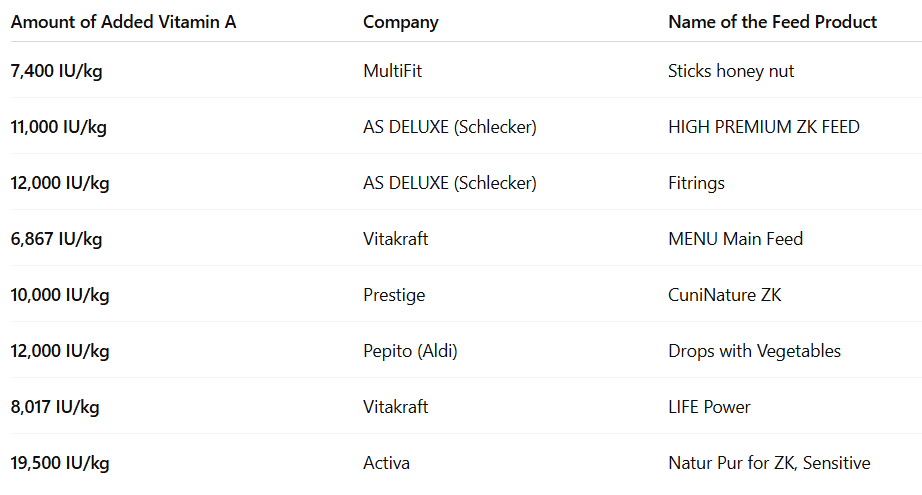
ZK = dwarf rabbit
These feeds are simply a mixed selection of products that were available to me; I did not choose them for any specific reason. According to the packaging, all of these feeds are intended for animals with a maintenance requirement (i.e., no increased nutritional needs).
The feed with the lowest added vitamin A in this selection contains 6,867 IU/kg. As shown above, rabbits need 290 IU/kg, meaning this product contains 23.7 times the required dose. The feed with the highest vitamin A content contains 19,500 IU/kg, which is 67.3 times the required amount.
Why is an overdose harmful?
Studies show that even a tenfold hypervitaminosis (overdose) already has negative effects. It can lead to the following disorders:
- Fetal resorption (fetuses are reabsorbed by the body)
- Abortions (miscarriages)
- Low birth weight in rabbit kits
- Hydrocephalus in offspring (abnormal accumulation of cerebrospinal fluid), often resulting in cognitive impairment and neurological disorders
- Strongly elevated vitamin A levels in the blood
- Vitamin A concentration in the liver increased by up to 180-fold
- Reduced feed intake
- Lower body mass gain
Let’s take a short detour into human medicine…
In one study, thirty thousand smokers were given 20 mg of synthetic beta-carotene daily. The hope was to reduce the rate of lung cancer. The result was alarming: the mortality rate increased by 8%, and lung cancer cases rose by 18%.
A second study was terminated early. Its setup was as follows:
A group of high-risk individuals (asbestos workers and smokers) received a daily dose of 30 mg synthetic beta-carotene and 250,000 IU vitamin A. Lung cancer cases increased by 28%, and 46% more participants died from lung cancer.
The amount of beta-carotene used in the study (30 mg) is roughly the amount found in a large carrot — a very small dose. So how can it have such drastic effects?
The explanation is straightforward: these were synthetic vitamins, and they can have harmful or even lethal effects. Natural vitamins, on the other hand, do not — because any excess is simply excreted. Since natural vitamins exist within a complex biological structure and are not chemically pure, the body can regulate them safely.
“Nutrients are both food and poison. The difference lies in the dose.”
– T. B. von Hohenheim –
But let me remind you once again: vitamin A is not even present in the natural diet of rabbits. Normally, rabbits cover their vitamin A needs with carotene.
Carotene = vitamin A?
In an experiment by Korman and Schlachter (1984), two groups of rabbits were fed identically, except that one group received vitamin A (20,000 IU) while the other received 40 mg β-carotene per kg of feed. The vitamin A levels in the blood were identical in both groups, and in the first generation they produced the same number of offspring.
However, in the second generation a significant difference appeared: the carotene group produced an average of 2.2 more kits per litter.
Other studies confirmed this effect: carotene consistently had a more positive impact on rabbit performance than vitamin A.
Conclusion: Rabbits experience complete excess — and therefore vitamin-A toxicosis with all its consequences — yet they lack carotene entirely, even though studies have shown that carotene has clear positive effects on their health.
“In my opinion, many of those responsible in the feed industry belong in prison. At least five years, without parole.”
– Prof. O. Wassermann, Toxicology Kiel, 1998 –
Can’t we perfectly imitate nature and produce a good feed?
Take a look at your own dry food at home — how much vitamin A does it contain? Many scientists now recommend comparing every additive listed on the packaging with the actual nutritional requirements of the animal, and choosing only those feeds that contain the ideal amounts.
However, this advice is not really feasible. First, you will hardly find any feed that meets these requirements, because almost all additives are overdosed. Second, the additive list only shows the synthetic portion of the vitamins, not the natural portion already contained in the raw ingredients. In reality, the values are therefore even higher.
Moreover, a responsible owner never feeds dry food alone; other foods are always added. Depending on what is supplemented, the nutrient values change significantly again.
One thing is also often forgotten: the German Nutrition Society (DGE) writes in “Reference Values for Nutrient Intake” – ISBN 3-8295-7114-3, 1st Edition 2000:
“The data on human requirements for essential nutrients are far from complete.”
If we are still unsure about the exact requirements of essential nutrients in humans — and if new essential nutrients continue to be discovered — what does that mean for rabbits?
Can a perfect dry feed with a perfect composition even exist?
And where is the individual nutritional need of each animal taken into account?
The alarming reality
A look at the rabbit feed market makes one thing immediately clear: almost none of the available products even meet the level suggested by current scientific knowledge.
Many additives are so heavily overdosed that serious harm to the animal must be assumed. Some feeds even contain poisonous plants. The energy content is generally far too high for maintenance needs, and the structural fiber that is essential for proper digestion is often completely missing — resulting in severe digestive problems.
At the same time, important nutrients such as carotene (see above) are missing altogether. Other nutrients that are not even necessary (e.g., B-vitamins) are added anyway, despite the fact that overdoses can cause significant damage.
Rabbits fed industrial feed suffer from deficiency in abundance:
- Lack of structural fiber → digestive problems, dental misalignment
- Hypervitaminosis (vitamin overdose) → various severe diseases
- Hypovitaminosis up to avitaminosis (vitamin deficiency) → multiple forms of damage
- Excess energy → obesity, fatty organs, diabetes, dental misalignment and abscesses
- Lack of secondary plant compounds
- Lack of moisture (even constant access to drinking water cannot fully compensate for the low moisture content of dry feed)
- …
Budget feeding – missing the animals’ actual needs
Another large group of rabbits is fed using a “modern” approach that avoids commercial mixed feeds because their harmful effects have become well known. People look for a cheap, practical, dry-food-free diet.
The most common version of this is a diet based on hay as the main food, supplemented with a small amount of vegetables given in 1–3 meals per day (→ rationed feeding). This diet does not come close to covering the animal’s requirement for essential nutrients, but it does provide an overdose of minerals.
Just enough to survive
The nutrient content of such a diet is far below that of the natural plants rabbits would eat in the wild.
Comparison: hay, vegetables, and meadow plants

β-carotene–rich plants (µg per 100 g)
(wild herbs highlighted)
- Nettle – 2400
- Celery stalks – 2900
- Swiss chard – 3530
- Orache – 3600
- Salad burnet – 4000
- Beet greens – 4500
- Spinach – 4687
- Fennel – 4700
- Sorrel – 5000
- Kale – 5169
- Parsley – 5413
- Chervil – 5500
- Dill – 6100
- Beets – 7794
- Carrot – 7794
- Root and tuber mixture – 7794
- Dandelion – 7900
β-carotene–rich dried components (µg per 100 g)
- Dried parsley – 13,871
- Dried dandelion – 22,268
- Dried chervil – 24,127
- Dried dill – 26,172
- Dried sorrel – 27,712
- Dried carrot – 34,820
Vitamin-E–rich plants (µg per 100 g)
(wild herbs highlighted)
- Nettle – 800
- Salad burnet – 1000
- Endive – 1000
- Lovage – 1000
- Spinach – 1367
- Orache – 1500
- Swiss chard – 1500
- Beet greens – 1500
- Red cabbage – 1700
- Dill – 1700
- White cabbage – 1700
- Kale – 1700
- Sorrel – 1900
- Dandelion – 2500
- Savoy cabbage – 2500
- Chervil – 2900
- Red pepper – 2900
- Parsley – 3703
- Peppermint – 5000
- Fennel – 6000
Wheat germ – 24,735
Rye germ – 12,600
Vitamin-E–rich seeds (µg per 100 g)
- Sunflower seeds – 37,770
- Pumpkin seeds – 4000
- Poppy seeds – 4000
- Flaxseed – 3000
- Sesame – 2530
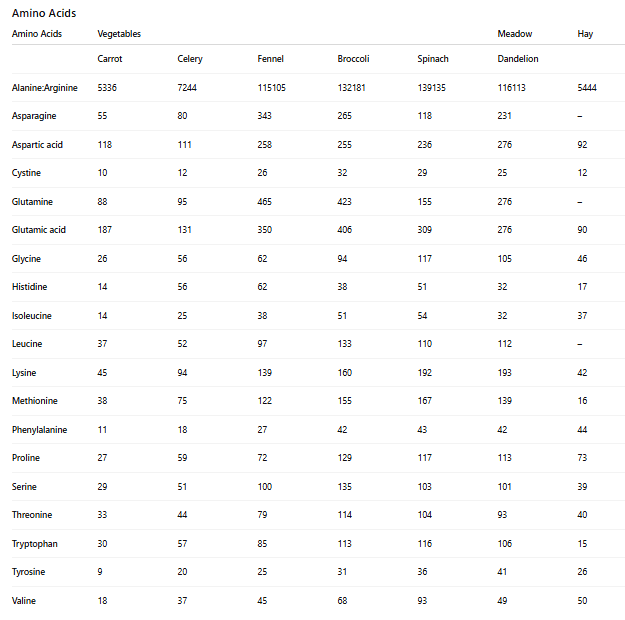
mg/100 g
** Celery stalks
– = No value available
In the scientific community, there is still no consensus about which amino acids are essential for which animals (growth, lactation, maintenance, etc.).
Therefore, all amino acids are listed here.
Water…
A rabbit’s body consists of up to 60% water, which is found inside and around the cells, in the blood, and in other body fluids.
Rabbits can survive a weight loss of up to 40%, but a loss of only 9% of their body water can be fatal.
A large amount of water leaves the body every day — partly through urine, but also through feces and breathing. This water must be replaced by the rabbit.
Chronic dehydration shows itself through calm behavior, reduced activity, fatigue, and other rather subtle symptoms.
Numerous studies have proven that rabbits do not take in nearly as much water from constant access to a bowl or bottle as they do when the water is already present inside their food. For this reason, diets based mainly on dry food lead to chronic dehydration in the long term.






